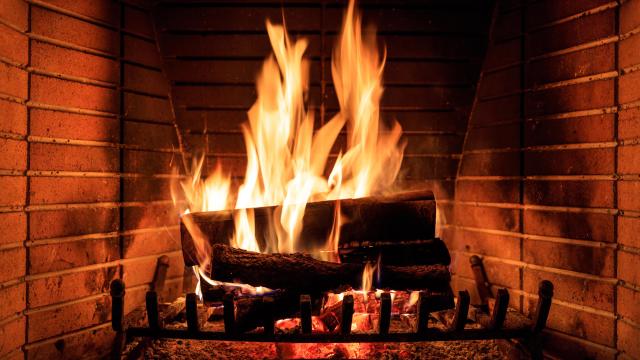Sitting around a crackling fire is one of the nicest, most serene winter activities. You have your hot chocolate or your wine, your book, your family — really blissful stuff is happening here. But you know what’s not blissful? When the fire pops, sending little bits of hot debris flying your way. It can be scary, painful, and even dangerous. Some firewood is more likely than others to pop, so here’s what to keep in mind next time you’re stocking up.
Why does firewood pop?
If you’ve ever cut into wood or picked up less-than-stellar lumber for a project, you know that wood isn’t totally solid all the way through. There are little pockets in it, and according to the Farmer’s Almanac, those can be filled with pitch, sap, and other flammables.They liquify as temps rise, eventually vaporizing, putting pressure on the walls of the pockets until they burst, making the popping sound. Per Fireplace Tips, there’s also some amount of water in the porous grains of the wood fibres that turns into gaseous steam in the heat. That steam can build in pressure until it bursts with a sharp pop.
The sound isn’t the only issue, though: Particles and embers can be shot out with the little blast, too, and can land in your living room or even hit you. Always make sure your screen is in place to prevent these from getting very far into your space.
Which woods pop the least?
According to Fireplace Tips, these types of wood are dryer than other varieties, so they won’t pop as much as a wetter wood would, making them a good choice for your fireplace:
- Apple
- Ash
- Birch
- Cherry
- Oak
- Maple
- Pine
- Walnut
- Beech
- Ironwood
- Aspen
- Cedar
You can also get wood that has been dried out a little. On the packaging, you’ll see if your wood has been kiln-dried or seasoned. Seasoned wood will pop a little more than kiln-dried wood because it retains a bit more water, but that water also helps it burn more efficiently.
Finally, wood pellets won’t pop, so if you’re really trying to cut down on the noise and risk of flying debris, you can opt for this more untraditional variety.
Which woods pop the most?
Softwoods, like pine and fir, pop the most. Of course, they have some of the nicer scents, too, so you’re trading off a little here. Softwoods have resin canals, where hardwoods don’t, and those canals are a big part of what makes wood pop. Softwoods are sappy, too — you can often see the sap on these trees. Taken together, this provides plenty of opportunity for moisture to lurk inside of these woods and eventually pop out when heated up.
Other softwoods to avoid if you don’t want popping are cedar, larch, poplar, and spruce.
How to store firewood
Stacking and storing your firewood correctly is key to drying and seasoning it. According to Family Handyman, stack it neatly outside on some type of plastic or a designated wood rack. (Keep it a good distance from your house, as it can attract rodents and is, of course, flammable.) Put the cut ends out in the open, make sure the wood is off the ground and away from any walls, and don’t pack it so tightly that the pieces on the bottom can stay damp. Put the stack in direct sunlight.
When storing it longterm, cover it with a tarp and tie it down after it’s been dried out in the sun.

Leave a Reply
You must be logged in to post a comment.